Understanding COP
Coefficient Of Performance
The complete guide to HVAC efficiency ratings, heat pump performance, and energy calculations
Expert HVAC Knowledge • Energy Efficiency • Performance Ratings
"What's a COP?"
COP measures how efficiently your heat pump or AC transfers heat compared to the electricity it uses.
COP Quick Reference
| Rating | Full Name | Equipment Type | Application | Purpose |
|---|---|---|---|---|
| COP | Coefficient Of Performance | Heat Pumps & Air Conditioners | Heating & Cooling | Energy Efficiency Rating |
What is the Coefficient of Performance?
The Coefficient of Performance (COP) is a performance rating that measures how effectively a heat pump or air conditioner transfers heat compared to the amount of electrical power it consumes.
How Heat Pumps Work
Heat pumps and air conditioners move heat from a low-temperature area to a high-temperature area, working against natural heat flow. This requires energy, and COP measures how efficiently this process happens.
Remember, heat pumps and air conditioners move heat from a low temperature area and pump this heat "uphill" to a high temperature area, working against the natural laws of thermodynamics. Heat naturally flows from hot to cold, but these systems reverse that process, requiring work to accomplish this feat.
Key Point:
If you want to know how much heat your system can transfer with a specific amount of power at a specific temperature, COP is your answer.
The COP tells us how effectively a heat pump or air conditioner performs this work by measuring the amount of power required to move a certain quantity of heat at a specific temperature from a low temperature area to a high temperature area.
How COP Differs from Other Efficiency Ratings
Other Ratings (SEER, HSPF, EER)
- • Measure efficiency over time periods
- • Compare different units (BTUs vs Watts)
- • "Apples to oranges" comparison
- • Seasonal or hourly averages
COP Rating
- • Measures instantaneous performance
- • Compares same units (Power vs Power)
- • "Apples to apples" comparison
- • Specific temperature conditions
Unlike SEER (seasonal efficiency), HSPF (heating season efficiency), or EER (efficiency over time), the COP demonstrates instantaneous performance without any factor of time involved.
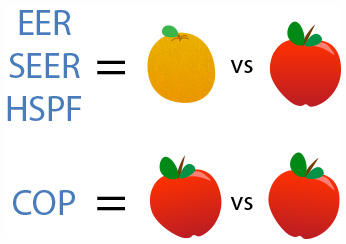
COP is expressed as a ratio of output power vs input power. For example: A heat pump with a COP of 4:1 means that for every 1 unit of electrical input power, it provides 4 units of heat output power.
The Physics Behind COP
"That's impossible!"
So a heat pump defies the laws of physics and creates more energy than it uses?
This would indeed be impossible! However, heat pumps achieve this greater output vs input feat because they don't create heat out of energy like a furnace does. Instead, heat pumps transfer heat from the outdoor environment and pump that heat into a home.
When transferring available thermal energy from one area to another, it requires much less energy than creating that same amount of thermal energy from electricity or other fuel sources.
The COP of heat pumps is always greater than 1 and represents a ratio of performance, not efficiency, because efficiency greater than 1 would imply creating something out of nothing.
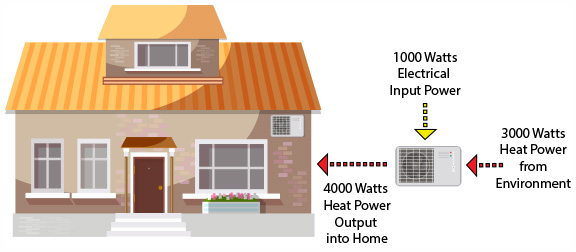
Understanding COP Calculations
"Wait... Watts of Heat?"
I thought heat was only measured in BTUs?
Unlike other efficiency ratings that compare "oranges to apples," COP compares two like things: Power Out to Power In - "Apples to Apples."

The COP is technically a "dimensionless" ratio because it compares two variables of the same type. Since electrical input power is commonly measured in Watts, COP is often expressed as Watts Out to Watts In.
However, since Watts can be converted to BTUs per Hour, we can use COP to determine heat output in BTUs/Hr when given electrical power in Watts:
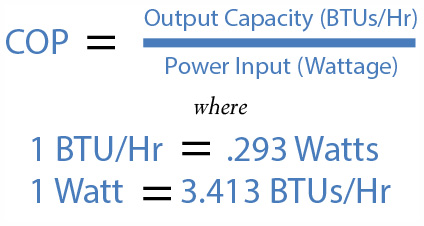
Conversion Example: If 1 Watt equals 3.413 BTUs/Hr, then 4000 Watts of output power equals 13,652 BTUs/Hr (4000 × 3.413 = 13,652 BTUs/Hr)
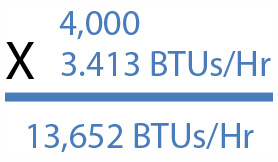
Minimum COP Efficiency Standards
The COP isn't required to be labeled on residential HVAC equipment, however, minimum COP standards are set for geothermal heat pumps and air source heat pumps greater than 5-tons:
Minimum COP Standards - Geothermal Heat Pumps
| Product Type | EER | COP |
|---|---|---|
| Closed Loop Water-To-Air Heat Pump | 17.1 | 3.6 |
| Open Loop Water-To-Air Heat Pump | 21.1 | 4.1 |
| Closed Loop Water-To-Water Heat Pump | 16.1 | 3.1 |
| Open Loop Water-To-Water Heat Pump | 20.1 | 3.5 |
| DGX Geothermal Heat Pump | 16.0 | 3.6 |
Minimum COP Standards - Commercial Air Source Heat Pumps
| Capacity | 47°F COP | 17°F COP |
|---|---|---|
| ≥65,000 - ≤135,000 BTUs/Hr | 3.3 | 2.25 |
| > 135,000 BTUs/Hr | 3.2 | 2.05 |
Houston Climate Advantage:
Houston's mild winters mean heat pumps maintain higher COP values year-round compared to colder climates.
COP Formula

COP = Power Output ÷ Power Input
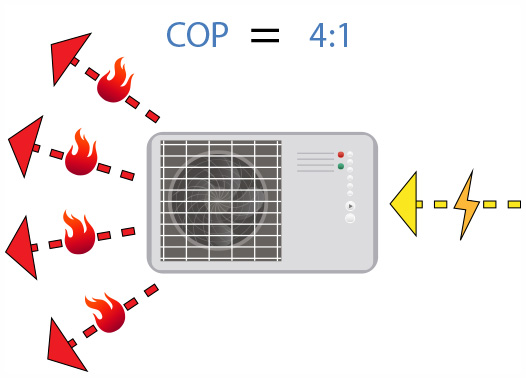
COP 4:1 Example
For every 1 unit of electrical input, this heat pump produces 4 units of heat output.
COP Quick Facts
- COP measures instantaneous performance
- Higher COP = better efficiency
- Heat pumps can achieve COP greater than 1
- COP varies with temperature
- Compares "apples to apples"
Temperature Impact
COP decreases as outdoor temperature drops
Houston Climate
Houston's mild winters mean heat pumps maintain excellent COP values year-round!
Calculating COP from Published Data
Learn how to find and calculate real COP values from manufacturer specification sheets using actual heat pump performance data.
So, our above example didn't list any reference to outdoor or indoor temperatures, but that's because we were just using a COP of 4:1 with a 4000:1000 Watt Heat Pump as an example to explain how the COP works. Real COP values are instantaneous values that represent performance at specific indoor and outdoor temperatures, and they also differ between a heat pump's cooling and heating modes. This means, there are 2 COP values for every heat pump - One COP is for cooling mode performance, while the other is for Heating mode performance.
So how about we examine and calculate the COP of a real heat pump and see how these values and temperatures actually affect performance?
Getting Product Specification Sheets
Now, as stated earlier, unfortunately the COP is not a performance rating that is required to be labeled on residential HVAC equipment in the United States, so you probably won't find COP data listed on the data plates located on the side of your HVAC system's components (we never have!), however, this data is usually listed in product specification data sheets, which can be obtained from equipment manufacturers.
The best way to go about getting a product specification sheet for your equipment is to ask your contractor, or by getting in touch with the manufacturer of your HVAC system. Contractors have accounts with manufacturers, and the dealers who sell the manufacturer's equipment, and as such an HVAC contractor can easily pull this data for you either by asking their equipment dealers for it, or by accessing a special contractor's section of a manufacturer's website and pull it themselves.
Without Product Specification Sheets
If you can't get a product specification sheet for your HVAC system, this limits your scope and precision of the COP data you can obtain. Without a product specification sheet you're essentially limited to converting cooling performance COP from an EER, or calculating seasonal heating performance from HSPF.
Real Example: 3-Ton Trane XR16 Heat Pump System
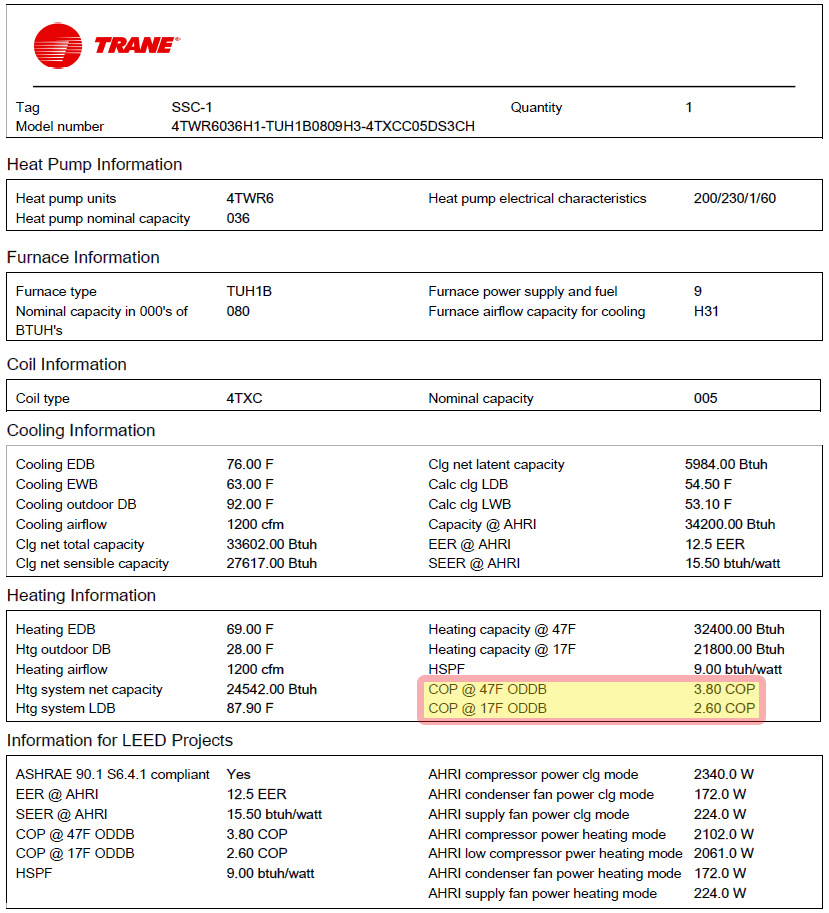
As you can see, we have highlighted the COP data for this 3-Ton Trane XR16 Heat Pump system's Heating Performance, which shows us 2 COPs for 2 separate outdoor temperatures including a COP of 3.80 at 47°F, and another COP of 2.60 at 17°F.
3-Ton Trane XR16 Heating Performance (COP)
| Outdoor Temperature | Indoor Temperature | Heating Output Capacity | COP |
|---|---|---|---|
| 47°F | 70°F | 32,400 BTUs/Hr | 3.80:1 |
| 17°F | 70°F | 21,800 BTUs/Hr | 2.60:1 |
"Wait.. So there are 2 different COPs for heating performance?"
Correct. There are actually many more, and technically there is a different COP for every difference in temperature between both the indoor and outdoor environment the system is operated within, however, on this product specification sheet we are only limited to viewing the heating performance data at 2 separate outdoor temperatures, including 47°F and 17°F. So, if you recall from our previous article where we discussed HSPF, these 2 temperatures may look a little familiar to you, that is to say, these temperatures are the required outdoor environment temperatures used in evaluating a system's HSPF efficiency rating.
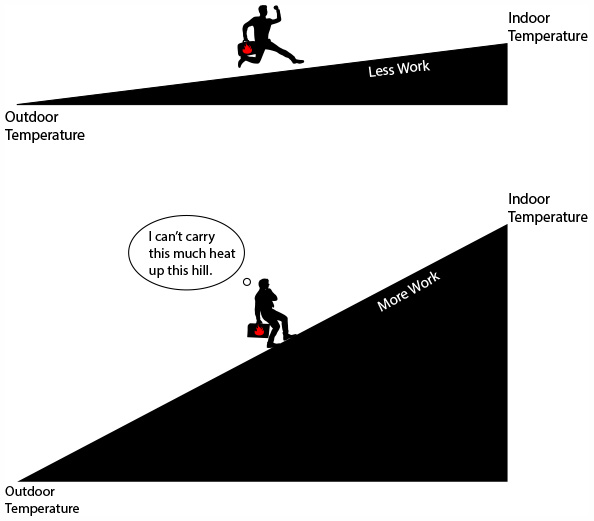
Using the analogy above with the hill and the man carrying heat, we can see: The further the "lift", or the "uphill" distance the heat pump has to face in order to move heat into a home, the more it has to work. Unfortunately, since a compressor can only do so much work, this inevitably means it loses output capacity, and ends up making the load of heat "lighter" in order to continue to move heat up a steeper slope and into the home.
"Ok that makes sense. But, I have my product specification data, and it doesn't say anything about a COP for Cooling Performance. Where is that COP listed?"
Converting EER to COP
Yeah.. So at this point you may have noticed the COP of Cooling Performance is not listed no matter where you look on this product specification sheet, and this is perfectly normal, as you probably won't find it listed on most product specification sheets because it's actually deceptively listed as an EER and in a BTUs/HR Output divided by Watt Hours Input format, or oranges to apples.


Alright, so our XR16's COP of Cooling Performance comes out to 3.6625:1, which means, for every 1 unit of electrical input power put into the heat pump, it outputs 3.6625 times as much heat. In this case, the heat pump is operating in cooling mode, which means it's transferring the heat outside of the home.
Complete Performance Data
3-Ton Trane XR16 Complete Performance (COP)
| Operating Mode | Outdoor Temperature | Indoor Temperature | Output Capacity | COP |
|---|---|---|---|---|
| Cooling | 95°F | 80°F | 34,200 BTUs/Hr | 3.6625:1 |
| Heating | 47°F | 70°F | 32,400 BTUs/Hr | 3.80:1 |
| Heating | 17°F | 70°F | 21,800 BTUs/Hr | 2.60:1 |
"Ok.. so I have all my COP performance ratings, but just what does this mean? How do I actually use this information?"
Converting COP to Watts
Right! So, what we need to do now is express our COP ratios as Watts of Output divided by Watts of Input. Our COP performance ratings right now simply tell us the difference between the numerator and denominator of our COP ratios. So, let's go ahead and convert things around into useful data.
Step 1: Convert Output to Watts
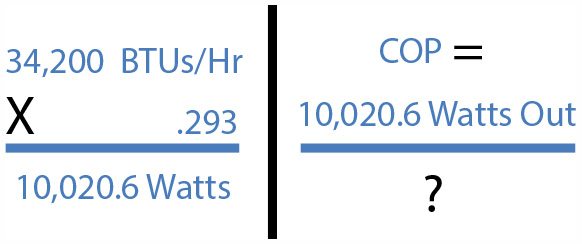
So, our COP for cooling performance is halfway expressed, the numerator (Watts of Output) comes out to 10,020.6 Watts, which is equivalent to 34,200 BTUs/Hr.
Step 2: Calculate Input Watts
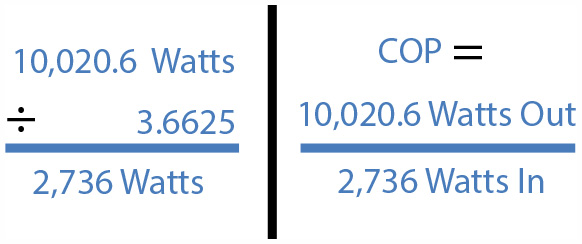
Alright! So our COP for Cooling Performance is now complete and the ratio is now expressed as Watts of Output versus Watts of Input. This means, that for every 2,736 Watts of Electrical Power put into the machine, it outputs (transfers) 10,020.6 Watts of Heat, or 34,200 BTUs/Hr for every 2,736 Watts.
Heating Performance Calculations
Heating at 47°F Outdoor Temperature
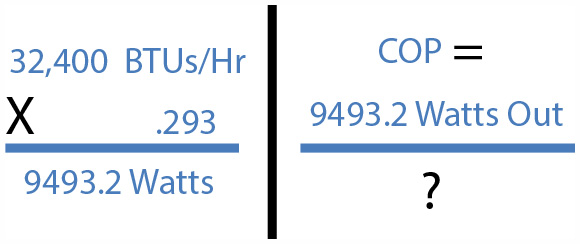
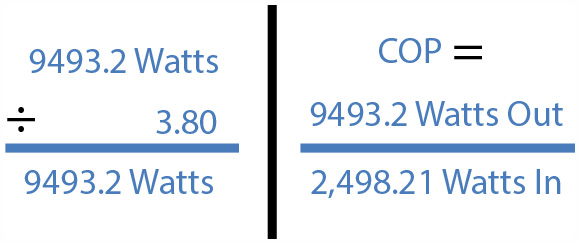
Ok, so we're done with the COP of Heating Performance at 47°F for this system, which comes out to mean that for every 2,498.21 Watts of Electrical Input, the machine Outputs (transfers) 9,493.2 Watts of Heat into the home, or 32,400 BTUs/Hr for every 2,498.21 Watts.
Heating at 17°F Outdoor Temperature

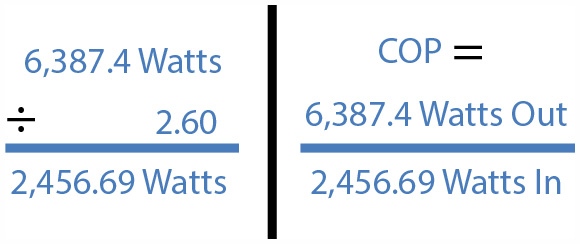
And there you have it! This ratio translates to meaning that for every 2,456.69 Watts of Electrical Input the heat pump transfers 6,387.4 Watts of heat into our home, or 21,800 BTUs/Hr of Output for every 2,456.69 Watts of Input. Awesome!
Key Takeaways
Get Specifications
Product spec sheets contain real COP data
Convert EER to COP
EER × 0.293 = COP for cooling
Temperature Matters
COP changes with temperature differences

